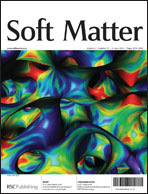Chain length dependence of the helix orientation in Langmuir–Blodgett monolayers of α-helical diblock copolypeptides†
Abstract
The effect of chain length on the helix orientation of α-helical diblock copolypeptides in Langmuir and Langmuir–Blodgett monolayers is reported for the first time. Amphiphilic diblock copolypeptides (PLGA-b-PMLGSLGs) of poly(α-L-glutamic acid) (


 Please wait while we load your content...
Please wait while we load your content...